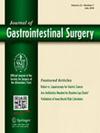肝切除术中单极浮球与双极镊子的对比:一项前瞻性随机临床试验。
IF 2.4
3区 医学
Q3 GASTROENTEROLOGY & HEPATOLOGY
引用次数: 0
摘要
背景:Pean-clasia肝横断术是主流技术,可使用不同的凝血剂。单极浮球(MFB)被提议用于肝横断术。单极浮球(MFB)在肝横断术中的价值尚不明确,其作为凝血剂的效率似乎很高。我们在一项前瞻性随机研究中比较了使用双极镊子(BF)的标准Pean-clasia与使用MFB的Pean-clasia在肝切除术患者中的应用:根据凝血器装置的不同,将 76 名计划进行肝切除术的患者随机分为两组:A 组(MFB,38 人)和 B 组(BF,38 人)。两组患者的肿瘤表现和肝脏背景特征相同。对失血量、输血量、横断时间、结扎次数、引流管排出量、术后第三天、第五天和第七天引流管胆红素水平、术后发病率和死亡率进行了前瞻性评估:在输血量(11.5% 对 16.5%;P = 0.450)、失血量/cm(2)(平均 7.2 对 7.6 毫升;P = 0.450)、横断时间/cm(2)(平均 2.1 对 2.3;p = 0.070)、结扎次数/cm(2)(平均 0.7 对 0.7;p = 1)、引流管排出量(平均 55 对 66.7 毫升;p = 0.451)和引流管胆红素水平(平均 1.9 对 2.1 毫克/分升;p = 0.664)。两组患者均无死亡或重大发病记录:这项研究表明,Pean-clasia与MFB联合使用是安全的,并最大程度地减少了肝切除术中的失血量。然而,与 BF 相比,MFB 的优势并不明显,而其成本也不容忽视。本文章由计算机程序翻译,如有差异,请以英文原文为准。
Monopolar Floating Ball Versus Bipolar Forceps for Hepatic Resection: A Prospective Randomized Clinical Trial
Background
Hepatic transection by Pean-clasia is the mainstream technique that can be used with different coagulators. Monopolar floating ball (MFB) is proposed for liver transection. Whether its value for liver transection is unclear, its efficiency as a coagulator only seems high. We compared in a prospective randomized study the standard Pean-clasia with bipolar forceps (BF) versus Pean-clasia with MFB in patients undergoing hepatic resection.
Methods
Seventy-six patients scheduled for hepatectomy were randomized in two groups, according to the coagulator device: group A (MFB, n = 38) and group B (BF, n = 38). The two groups were homogeneous in terms of tumor presentation and background liver features. Blood loss, blood transfusions, transection time, number of ligatures, drain discharge, drain bilirubin levels at third, fifth, and seventh postoperative day, and postoperative morbidity and mortality were prospectively evaluated.
Results
No significant differences between groups A and B were seen in terms of blood transfusions (11.5% versus 16.5%; p = 0.450), blood loss/cm2 (mean 7.2 versus 7.6 ml; p = 0.450), transection time/cm2 (mean 2.1 versus 2.3; p = 0.070), number of ligatures/cm2 (mean 0.7 versus 0.7; p = 1), drain discharge (mean 55 versus 66.7 ml; p = 0.451), and drain bilirubin levels (mean 1.9 versus 2.1 mg/dl; p = 0.664). No mortality or major morbidity was recorded in both groups.
Conclusions
This study showed that association of Pean-clasia with MFB was safe and minimized the blood loss during hepatic resection. However, MFB did not offer significant benefits over BF, while its cost is not negligible.
求助全文
通过发布文献求助,成功后即可免费获取论文全文。
去求助
来源期刊
CiteScore
5.50
自引率
3.10%
发文量
319
审稿时长
2 months
期刊介绍:
The Journal of Gastrointestinal Surgery is a scholarly, peer-reviewed journal that updates the surgeon on the latest developments in gastrointestinal surgery. The journal includes original articles on surgery of the digestive tract; gastrointestinal images; "How I Do It" articles, subject reviews, book reports, editorial columns, the SSAT Presidential Address, articles by a guest orator, symposia, letters, results of conferences and more. This is the official publication of the Society for Surgery of the Alimentary Tract. The journal functions as an outstanding forum for continuing education in surgery and diseases of the gastrointestinal tract.

 求助内容:
求助内容: 应助结果提醒方式:
应助结果提醒方式:


